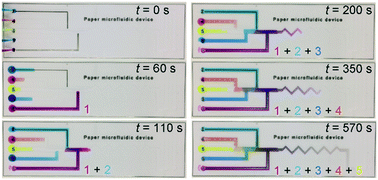Quantitatively controllable fluid flows with ballpoint-pen-printed patterns for programmable photo-paper-based microfluidic devices†
Abstract
Regulating the fluid flow in microfluidic devices enables a wide range of assay protocols for analytical applications. A programmable, photo-paper-based microfluidic device fabricated by using a method of cutting and laminating, followed by printing, is reported. The flow distance of fluid in the photo-paper-based channel was linearly proportional to time. By printing silver nanoparticle (AgNP) and poly[4,5-difluoro-2,2-bis(trifluoromethyl)-1,3-dioxole-co-tetrafluoroethylene] (PTFE) patterns on the surface of a photo-paper-based channel, we were able to either increase or decrease the fluid flow in the fabricated microfluidic devices, while maintaining the linearity in the flow distance–time relation. In comparison to the speed of fluid flow in a pristine channel, by using hydrophilic AgNP patterns, we were able to increase the speed in the channel by up to 15 times while we were able to slow the speed by a factor of 3 when using hydrophobic PTFE dots. We then further demonstrated a single-step protocol for detecting glucose and a multi-step protocol for detecting methyl paraoxon (MPO) with our methods in photo-paper-based microfluidic devices. This approach can lead to improved fluid handling techniques to achieve a wide range of complex, but programmable, assays without the need for any additional auxiliary devices for automated operation.



 Please wait while we load your content...
Please wait while we load your content...